He received a detailed analysis of wear and shoes and brought advice on creating a "ideal" wardrobe.

Olof Hoverfelt noted what things and when wearing, and then analyzed the data and learned the wear indicators.
Now he understands which expensive things to buy more profitable cheap, which loves to wear, and saves on the purchase of clothing, which would have been lying in the closet or quickly worn out.
In the publication at reaktor, the Covers disassembled observations, and at the same time shared his advice, how to choose clothes and shoes.

How and what data collected the developer
In total, the Covers collected in the diary 426 items with 300 thousand tags about the use and non-use of the thing.
The wardrobe was divided into 12 categories: jackets and hoodies, blazers, knitwear, shirts, t-shirts, pants, shorts, belts, socks, shoes, underwear, shirts and boxers. Sportswear did not enter the set of "everyday" socks.
At first, the developer introduced data on wear to Excel, but gradually the application began to slow down, and the hoverfelt has developed its platform for collecting and visualizing data based on the R language R, and the data from Excel has transferred to the "cloud" google sheets.
Every evening, the hoverfelt opened the browser and made a list of active clothes, which was wore throughout the day.
He also added new purchased clothing and its cost to calculate the "wear value" of things (COST PER WEAR, CPW) in one day.

Such an indicator "equalizes" all things in the wardrobe regardless of the price, and also helps to answer the question whether the quality of things with the price correlates.
What found out Hoverfelt
In some cases, buying cheap clothes turned out to be more expensive. For example, CONVERSE sneakers for € 90 and MyWear for € 30 turned out to be comparable CWP - € 0.87 and € 0.7, respectively.
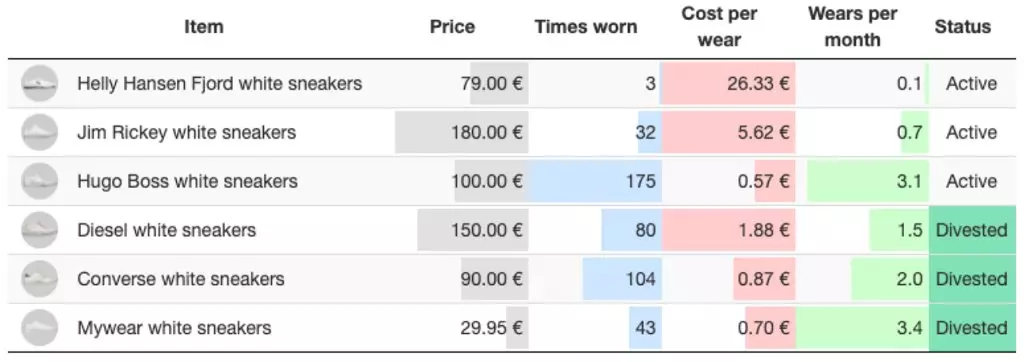
This means that walking in the cheap mywears is about the same as expensive as in Converse. They cost more, and this amount can be "to buy quality", because about two pairs of myWears are required to fit one concresse pair.
"From the point of view of sustainable development, one pair is better than two, even if items have facilities of wear," concludes the author.
On the other hand, Diesel for € 150 turned out to be much worse - their CPW at € 1.88 more than twice as high. And let them live halfway longer than MyWears, their fivefold difference in value proves that the purchase of Diesel was ineffective.
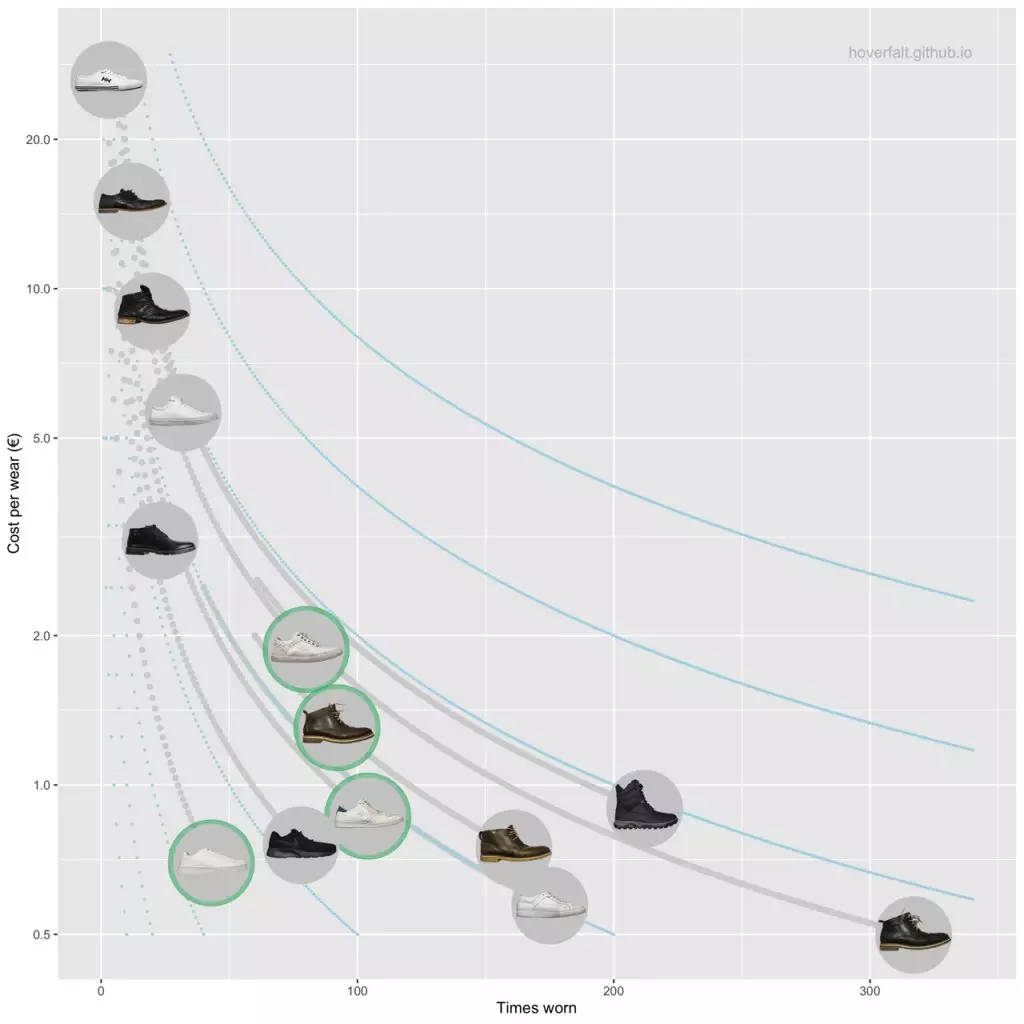
But the rule is "miserly paying twice", although it is confirmed in this example, but it does not always work, the countlith notes.
For example, its shirts can be divided into two categories: "relatively expensive" and "less expensive" - from € 100 and up to € 40 and below. The expensive CPW shirts amounted to € 3.44 before he sold them, while depleting - € 1.29 and continues to decline.
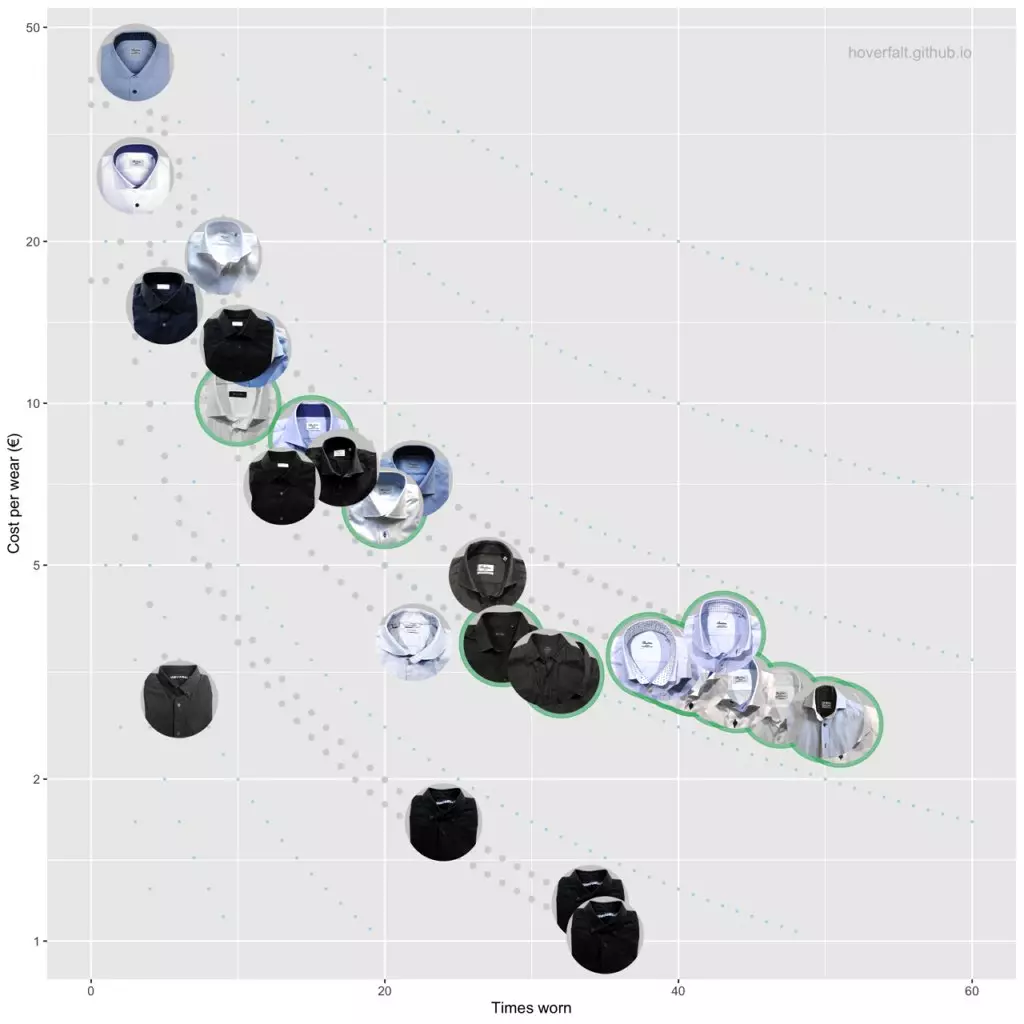
It turns out that their purchase turned out to be much more successful in terms of economic efficiency.
But here the hoverfelt notes - "the quality is not limited to durability and can not be measured only by it," and expensive shirts can give more valuable subjective experience of wearing (materials, style, details, brand, cutting and other indicators) that can justify the difference in CPW .
The developer checked the data on the purchase and use of shirts and in their behavior (the number of sock) was to quantify the difference in the "values" of things - as far as he is willing to overpay for the "premium experience".
It turned out that on average he is ready to pay around € 2 for each shirt sock - and thus determined the optimal balance between cost and quality.
Another indicator that analyzed the hoverfelt is the socks frequency to determine the "popularity" of each thing. What it is higher - the better, since it means that either a thing like the owner, or it is well combined with other elements of the wardrobe, or both.
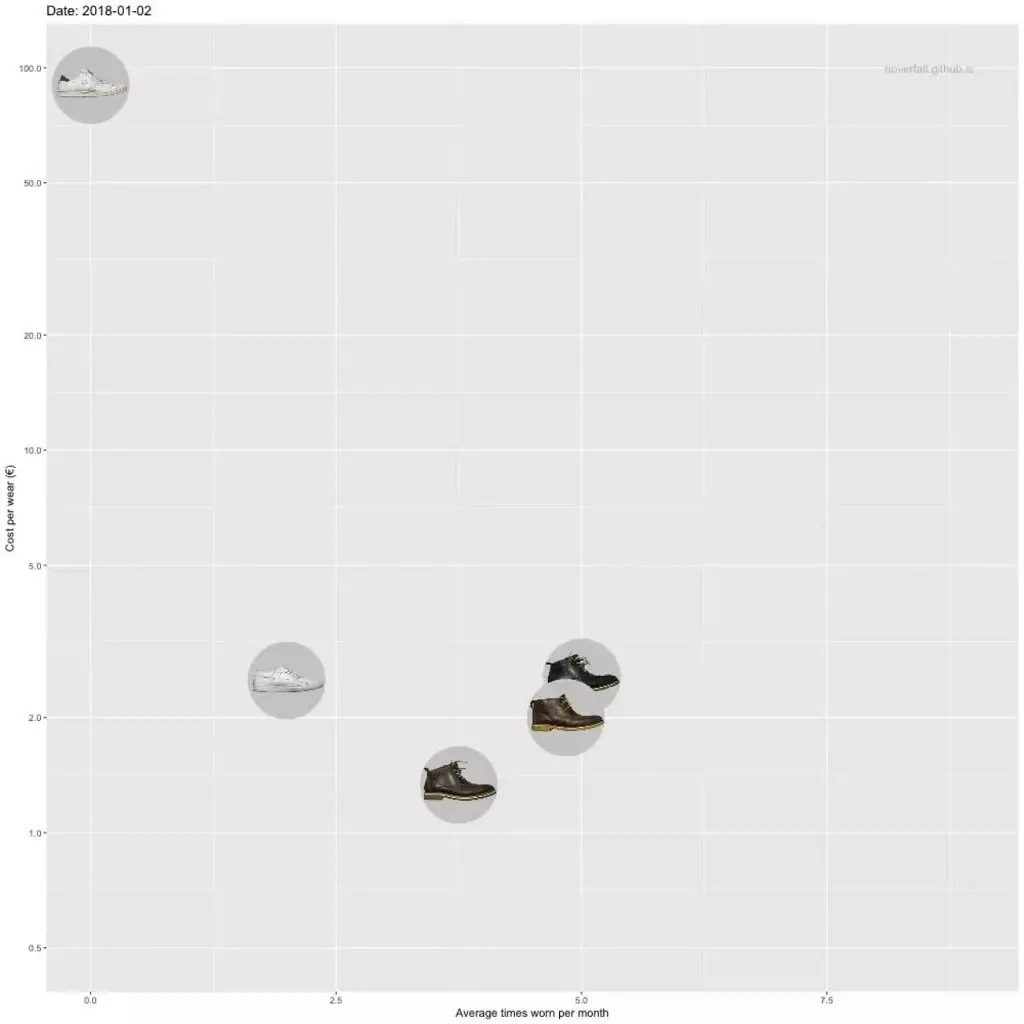
The sock frequency indicator helped determine what things were purchased in vain, and which "compete" among themselves for affordable days. Thus, you can make a wardrobe with your favorite clothes that will remain cost-effective.
What about washing
Another clothing indicator is its dependence on the washing frequency. For example, shirts, t-shirts, socks and linen are erased after each use, which means they will not be available for the next wearing over several days. Belts, jackets, pants and shoes are less limited in this.Hoverfelt called frequently washed things "limited", and unstable - "unlimited". He analyzed how the washing is affected by the frequency of use of the subject and its "competitiveness" compared to other subjects of the same category.
The key conclusion - in "unlimited" categories should be a small number of things that are used often, and in "limited" one can be more diverse. But in the set of "limited" things there must be so much clothing so that it is cyclically erased and not idle without a case.
Wardrobe as a "asset portfolio"
The last indicator that calculates the hoverfelt is the daily cost of the category, the sum of all CPW category per day. It allows you to see how long the day value from the items used is changing and which of them are used longer.

It helps to appreciate the cost of "utility" of a particular type of clothing and understand how much the owner daily costs underwear and other things.
All indicators of the hoverflite combined on the charts to evaluate its wardrobe completely. The graph below shows the average CPW and category use frequency.
It shows which categories more expensive, and which are often used, and allows us to find out efficiency: how high can CPW be for clothing, which is rarely worn and which serves a long time.

For example, blazers seem expensive: they are six times more expensive trousers, but they are much less common, and it means that their annual cost may not be so bad. To find out, the developer translated CPW in the annual cost.
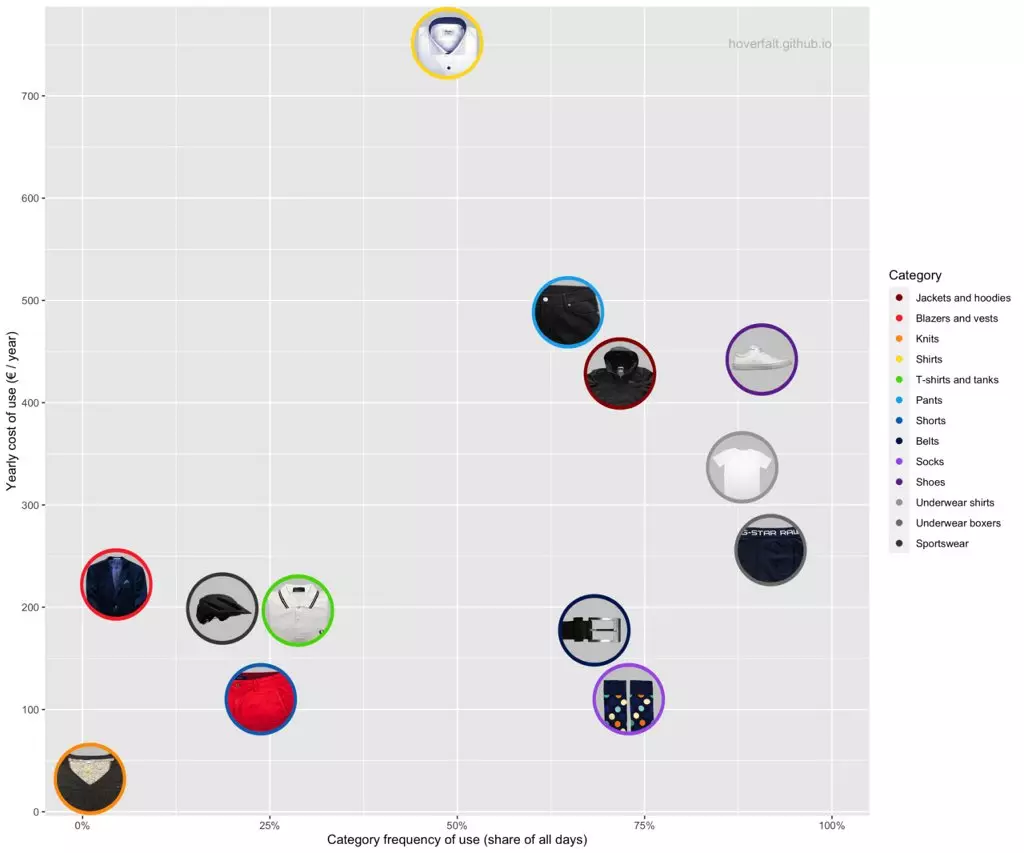
An anomaly in the shirts are noticeable in the chart for which the hoverfelt spends about € 750 per year. He explains this with love for high-quality shirts. By his calculations, it can save about € 500 per year in this category, but does not plan to do this.
"I like my trendy shirts, and now that I see it, I am satisfied with the price. This is a conscious choice. And at the same time, the feeling of guilt was disappeared about how reasonably buying them, "the hoverflite notes.
He plans to further make data into a schedule and improve purchases.
There are two indicators that he wants to explore more. For example, stability - the developer plans to take into account the weight indicators and composition of materials when measuring the efficiency of clothing.
The second task is to expand the comparability of expenses from clothing to other material assets.
Ideal wardrobe: Tips for replenishing stocks in the closet
At the end of the analysis, the author brought several examples of how to cut the wardrobe and save.
- Find what you need and then buy only it. It sounds simple, but there is a big difference between a real need in two weeks and "I need it!", While in the store.
- Focus on use, not the price. Usage is value, and as in the case of any compromise between price and quality, you first need to look for quality, and then think about restricting spending. More expensive clothes may be cheaper.
- Avoid the "second level" clothes. These are things that seem to be good, but never wear, because there is something similar, but a little better. It makes sense to have only beloved clothes.
- Avoid clothes for rare cases. Straighure it to be most compatible with each other and created many combinations.
- Create maximum compatibility between categories. One way is to limit the color palette of things. Incompatible things increase the size of the wardrobe, reduce the use and its effectiveness. It also reduces the cognitive burden on the search for suitable combinations.
- Buy in walking. Some high-quality goods may have to be worn for years so they become effective.
- Take care of clothes. Constant care and small corrections can double the service life. It also makes sense to repair good things in a tailor, for example, you can replace lightning - these are frequent killers of clothes.
- Know when selling. Despite the desire to use things as long as possible, there is a limit after which it is just unprofitable. Getting rid of the subject should not blame himself - he served well.
- Clothes should look good. To put clothes in the wardrobe should be as pleasant as going shop.
- Take your weakness. Everyone has weaknesses. And despite the optimization of expenditures on clothing, there is still something that I want to buy more than it followed.
# Clothing # savings # analysis # shoes
A source
